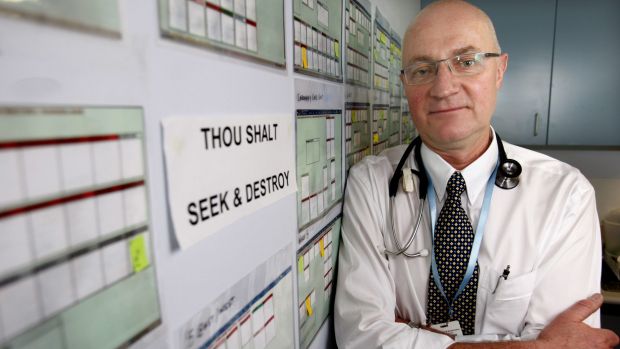
The director of the infectious diseases department at Austine Hospital, Professor Lindsay Grayson, says measles cases put a huge strain on medical resources and could be avoided through vaccination. Photo: Angela Wylie
The number of people being diagnosed with measles in Australia hit a 16-year-high in 2014, as scores of travellers brought the potentially fatal disease into the country and unvaccinated children fell victim to it.
Health department data shows a total of 340 measles cases were recorded in Australia during the year, the highest number since 1998. The rate of measles cases also peaked in 2014, with about 15 cases for every million people in Australia.

Australia’s measles vaccination program has seen the incidence of the disease fall since the 1990s.
While numbers are a fraction of those recorded in the1990s, National Notifiable Diseases Surveillance System figures show there were just 10 cases in 2005, the best year on record.
Measles is a highly infectious disease that can cause serious illness, including inflammation of the brain, particularly in very young children and adults.
Robert Booy, of the National Centre for Immunisation Research and Surveillance, said many of 2014’s cases were from unvaccinated people who had been infected overseas then returned to Australia.
In the early 1990s, there were up to 4500 measles cases a year, but numbers steadily fell in the following decade.
Professor Booy said the drop in cases was thanks to Australia’s measles vaccination program, which provides two vaccine shots before a child reaches school age.
A spokeswoman for the federal Department of Health said there were 140 imported cases of measles in 2014, which had led to a further 115 infections.
“These cases were mainly associated with outbreaks occurring in the Philippines and Indonesia at the time,” she said.
Professor Booy said the disease did not tend to spread beyond three people in such cases, because more than 90 per cent of Australia’s population was vaccinated, but there were pockets of lower immunity.
Brunswick has Melbourne’s lowest vaccination rate for five-year-old children, with 8.5 per cent not fully immunised.
In 2014, there were 62 cases of measles in children under the age of five nationwide, the highest number since 1999.
Professor of infectious diseases at Austin Health and the University of Melbourne Lindsay Grayson said the surge in cases last year reflected patchy vaccination rates among children.
“There is absolutely no excuse. All children should be vaccinated for measles.” he said. “Any parent that does not get their child vaccinated for measles is brain dead.”
Professor Grayson said a handful of measles cases had presented at Melbourne’s Austin Hospital in the past year, including refugee families who had missed out on vaccinations. But he said most cases were “Australians who did not want to have their kids vaccinated”.
He said each measles case dealt with at the hospital’s emergency department put considerable strain on resources, with the patient with measles having to spend time in an isolated unit. About 100 to 150 people potentially exposed in the hospital’s waiting room also had to be monitored, while nurses had to contact friends and relatives of the infected person and carry out blood tests to assess infection risks.
“It is a huge diversion of resources to look after a patient with a disease that could have been avoided with vaccination,” Professor Grayson said.
So far in 2015, there have been 40 measles cases, including that of an unvaccinated Brisbane paramedic, who potentially exposed 4500 people to the disease, which has led to calls for all health staff to be vaccinated.
The Victorian branches of the paramedics‘ and nurses’ unions have resisted such calls, acknowledging the importance of immunisation, but saying staff should not be discriminated against for choosing not to be vaccinated.
Professor Grayson said the unions needed to “get real” about their stance towards immunisation.
“Measles is one of those things where the rights of the community are larger than the rights of the individual.”
In Victoria, there were 75 measles cases in 2014, a state health department spokesman confirmed, with 53 of these arising from 10 outbreaks caused by someone bringing the disease into the country. There were no deaths from measles in Victoria., the spokesman said.
